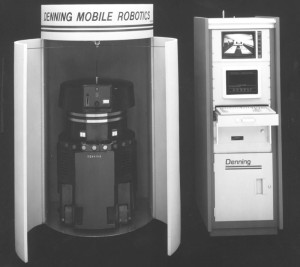In the early ’90s I worked briefly at a company called Denning Mobile Robotics. At the time I arrived, about eight years after the company’s founding, Denning had developed an ambitious robot called Sentry. Sentry was a security robot designed to patrol the corridors of a warehouse, office, or other facility after hours.
Sentry was a marvel of engineering—especially considering the technology available at the time. Sentry used a ring of sonar sensors to detect obstacles and follow walls; it used infrared and microwave motion sensors to detect intruders and a video camera to transmit a picture back to the security station. Sentry could follow a programmed path (relying on previously installed, active beacons) and would automatically return to its charging station to recharge its batteries. The robot gave impressive demonstrations.
Over the course of several years many talented, capable people designed, built, and programmed Sentry. These robot pioneers were justifiably proud of their achievement. But a commercial robot must please its customers not its builders and this is where the trouble started.
Sentry was placed at several customer sites. Denning management was confident that Sentry would be well received and gave the trial companies favorable terms. But after a few months all the robots were sent back to Denning. No one wanted to buy or lease Sentry.
Engineers sitting around the lab might imagine that a security robot would frequently encounter intruders. Maybe the voice of the guard relayed through the robot would instruct the would-be burglar to surrender or flee. Maybe the robot would even give chase. Unfortunately, Denning discovered that’s not what security staff spend most of their time doing. Instead guards do things like check the doors to make sure that they are locked, turn off the lights and the coffee pot, maybe turn down the thermostats to save energy. Sentry couldn’t do any of those things.
Sentry could roll along a corridor and report unexpected movement. For that customers had to outfit their office or warehouse with beacons and pay Denning $75,000. And someone was still needed to check that the doors were locked and the coffee pot turned off. Companies concluded that Sentry’s service wasn’t worth the price.
Denning’s example—involving people I knew—of fruitless effort and dashed hopes, dramatically illustrated to me that great technology isn’t enough. Building a really cool robot nobody wants is just an exercise in disappointment. If your work is to count for something you have to solve a problem people want solved at a price they’re willing to pay. Fulfilling a customer need at a competitive price makes a robot practical. But achieving practicality is deceptively hard.
